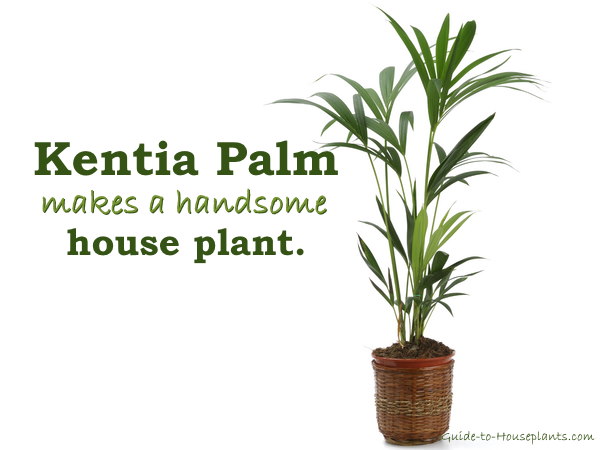Caring for Kentia Palm Tree
Kentia palm tree makes a dramatic houseplant, lending a lavish, tropical vibe to any brightly lit room. It's slow-growing, so get one the size you want.
Howea forsteriana is one of the few kinds of palm trees that really thrive indoors. Here, you'll discover how to keep it healthy indoors, with tips for trimming brown fronds, when to water, fertilize, and repot.

Get to Know Kentia Palm Tree
Kentia palm is known botanically as Howea forsteriana. Native to Lord Howe Island (Northeast of Australia), this tropical palm tree is well suited for warm temperatures year-round.
Over many years, a kentia palm tree can reach 8 ft (2.4 m) in height indoors, making it an eye-catching floor plant. Give it some elbow room, too. Those elegant, arching fan-shaped fronds can grow as much as 1 ft (30 cm) wide and at least 2 ft (60 cm) long.
All of them grow from a single trunk, but greenhouse growers typically plant several together for a lush, full appearance. This is hands-down one of the most popular indoor palm trees, and it's easy to see why.
The palm family is large, but only a few kinds of palm trees are tolerant of average home conditions. This dramatic palm is one.
If you need another reason to love this plant, you can rest assured that it's pet-safe. According to the ASPCA, Kentia palm is non-toxic to cats and dogs.
Kentia Palm Problems, Solutions and Special Helps
Give it a shower. Keep the fronds dust-free by giving your palm a shower. This has the added benefit of flushing the soil of built-up fertilizer. Use a gentle flow of tepid water. Or stand the plant outdoors for a gentle summer (warm) rain shower. Remember to keep your palm out of direct sun.
Watch for scale insects. They look like brown oval bumps that tend to lurk on the undersides of the leaflets. Treat any infestation immediately. Dry indoor air can attract spider mites to indoor plants; if left untreated, they can cause a lot of damage to a plant then move on to your other houseplants. Maintaining humidity is the best prevention for these pests -- and your tropical palm will love it.
Repot only when needed. Repotting is only necessary every 3 years at the most. Kentia palm trees are slow-growing and don't like to be disturbed. Their roots are fragile, so handle them carefully. Spring is the best time to repot, when this plant is beginning its most vigorous time of growth.
Brown leaf tips are common even on healthy palms. Boosting the humidity around your plant will help. Watch humidity levels, especially during the winter months when indoor air can become extremely dry.
Leaflets that turn yellow, then brown are over-watered. Palms need regular watering, but will protest soggy soil. Use a pot with drainage holes. If you want to cover a plain nursery pot, slip it into a decorative cachepot. I use small river rocks in the bottom of cachepots to keep the inner pot above the drainage water.
Kentia Palm Tree Indoor Care
Light: Kentias tolerate shade better than some, but you'll get a healthier, greener plant by giving your palm bright, indirect light year-round. Take care not to put it in direct sunlight, which may cause brown scorch marks on its leaves.
Water: Keep soil lightly moist spring through fall. In winter, allow the top half of the soil to dry out before watering again. Too much water will cause leaves to turn yellow then brown. To keep Kentia palm looking its best, brown fronds can be cut off.
Humidity: Kentia palm tree likes high humidity (around 50-60% relative humidity). If the relative humidity drops below 40%, use a cool-mist room humidifier. Brown leaf tips are a symptom of dry air, although this is common even on healthy palms.
Temperature: Warm room temperatures 75-80°F/24-27°C during the day, and slightly cooler 60-65°F/16-18°C at night.
Soil: Peat moss-based potting mix with added horticultural sand for quick drainage.
Fertilizer: Feed monthly in spring and summer. Organic palm fertilizer contains the micronutrients this palm needs. Don't feed in fall and winter when growth has slowed.
Propagation: Kentia seeds can be grown with a grow light and heat mat, but seedlings are slow-growing. You'll wait for years for seedlings to grow into a tall palm tree.


